In many cases, you can compute ![]() by plugging a in for x:
by plugging a in for x:
![]()
For example,
![]()
This situation arises often enough that it has a name.
Definition. A function ![]() is continuous at a if
is continuous at a if
![]()
This definition really comprises three things, each of which you need to check to show that f is continuous at a:
1. ![]() is defined.
is defined.
2. ![]() is defined.
is defined.
3. The two are equal: ![]() .
.
What does this mean geometrically? Here are the three criteria above in pictorial language:
1. "![]() is defined" means there's a point on the graph
at a.
is defined" means there's a point on the graph
at a.
2. "![]() is defined" means
the graph approaches a single numerical value as you get close to a.
is defined" means
the graph approaches a single numerical value as you get close to a.
3. "![]() " means
that the value you're approaching is the value that f actually takes
on --- there are "no surprises".
" means
that the value you're approaching is the value that f actually takes
on --- there are "no surprises".
The first criterion means that there can't be a hole or gap in the graph. This also rules out vertical asymptotes. Here are some pictures of these kinds of discontinuities:
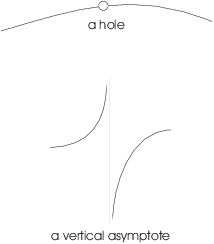
The second criterion means that the graph can't "jump" at a. This is a jump discontinuity:

A jump discontinuity occurs when the left and right-hand limits aren't equal.
The third criterion means that the graph is "filled in" at
![]() as you'd expect. You don't get close to a
expecting one value and then find that
as you'd expect. You don't get close to a
expecting one value and then find that ![]() is something
different, as you do below:
is something
different, as you do below:
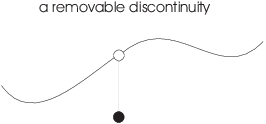
This is called a removable discontinuity
because you could make the function continuous by filling in the
hole. In terms of limits, it means that ![]() exists, but
exists, but ![]() .
.
Here are some classes of continuous functions:
(a) A polynomial ![]() is continuous for all x.
is continuous for all x.
(b) ![]() is continuous for all x.
is continuous for all x.
(c) Trigonometric functions are continuous wherever they are defined.
(d) ![]() is continuous for all x and
is continuous for all x and ![]() is continuous for
is continuous for ![]() .
.
(e) ![]() is continuous for all x for which it's
defined.
is continuous for all x for which it's
defined.
The statement about polynomials, for example, follows from a property
of limits. If ![]() is a polynomial, I showed that
is a polynomial, I showed that
![]()
This is exactly what it means for ![]() to be continuous at
c.
to be continuous at
c.
For example, ![]() is continuous for all x,
since it's a polynomial.
is continuous for all x,
since it's a polynomial.
The statement for ![]() is a fairly easy limit proof, but I'll omit
it. And the statements for trig functions,
is a fairly easy limit proof, but I'll omit
it. And the statements for trig functions, ![]() , and
, and ![]() depend on careful definitions of these functions;
I'll discuss some of this later. As an example of the statement about
trig functions,
depend on careful definitions of these functions;
I'll discuss some of this later. As an example of the statement about
trig functions, ![]() is continuous for all x except odd
multiples of
is continuous for all x except odd
multiples of ![]() . (
. (![]() is undefined at odd
multiples of
is undefined at odd
multiples of ![]() .)
.)
The limit proof for ![]() is not too hard, but once you have
results on
is not too hard, but once you have
results on ![]() and
and ![]() , you can use the fact that
, you can use the fact that
![]()
You have to ensure that the root you're taking is defined at the
point. For example, ![]() is continuous for
is continuous for ![]() . Remember that
. Remember that ![]() is undefined for
is undefined for
![]() .
.
Example. What kind of discontinuity does ![]() have at
have at ![]() ?
?
Note that
![]()
However, ![]() is undefined. Therefore, there is a removable
discontinuity at
is undefined. Therefore, there is a removable
discontinuity at ![]() . I could make the function continuous at
. I could make the function continuous at
![]() by defining
by defining ![]() .
.![]()
Example. Let
![]()
What kind of discontinuity does ![]() have at
have at ![]() ?
?
Note that
![]()
Thus, the left and right-hand limits aren't equal. Therefore, there
is a jump discontinuity at ![]() .
.![]()
You can also get continuous functions by combining continuous functions in various ways.
Theorem. (a) If f and g are continuous at ![]() , so is their sum
, so is their sum ![]() .
.
(b) If f and g are continuous at ![]() , so is their difference
, so is their difference ![]() .
.
(c) If f and g are continuous at ![]() , so is their product
, so is their product ![]() .
.
(d) If f and g are continuous at ![]() , and if
, and if ![]() , then the quotient
, then the quotient ![]() is continuous
at
is continuous
at ![]() .
.
(e) If f is continuous at ![]() and if g is continuous at
and if g is continuous at ![]() , then the composite
, then the composite ![]() is continuous at
is continuous at ![]() .
.
Proof. The proofs are fairly easy consequences of our theorems on limits. I'll prove (c) by way of example.
Suppose f and g are continuous at ![]() . This means that
. This means that
![]()
Multiplying the left sides and the right sides, I get
![]()
By the rule for the limit of a product,
![]()
Therefore,
![]()
This is what it means for ![]() to be continuous at
to be continuous at ![]() .
.![]()
Here are some illustrations of these rules.
Since ![]() and
and ![]() are continuous for all x, their sum
are continuous for all x, their sum ![]() and their product
and their product ![]() are continuous for
all x.
are continuous for
all x.
The quotient ![]() is continuous for all x except
is continuous for all x except
![]() (where the quotient is undefined).
(where the quotient is undefined).
Composition is an important method for constructing continuous
functions. For example, ![]() is continuous for all x. The
polynomial
is continuous for all x. The
polynomial ![]() is also continuous for all x.
The composite is
is also continuous for all x.
The composite is
![]()
It is continuous for all x.
Example. Let

For what values of x is f continuous?
The function is continuous except possibly at the "break
points" between the three pieces. I must check the points ![]() and
and ![]() separately.
separately.
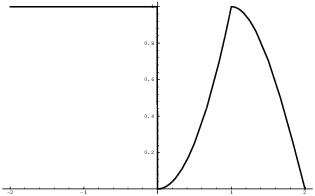
At ![]() ,
,
![]()
Since the left- and right-hand limits do not agree,
![]()
Hence, f is not continuous at ![]() .
.
At ![]() ,
,
![]()
The left- and right-hand limits agree, so
![]()
Now ![]() , so
, so
![]()
Therefore, f is continuous at ![]() .
.
Conclusion: f is continuous for all x except ![]() .
.![]()
Example. Let
![]()
For what values of x is f continuous?
f is a quotient of two polynomials, and polynomials are continuous
for all x. Hence, ![]() is continuous at all points except those
which make the bottom equal to 0.
is continuous at all points except those
which make the bottom equal to 0.
Write f as
![]()
Hence, f is continuous for all x except ![]() and
and ![]() . (Note that you can't cancel the
. (Note that you can't cancel the ![]() -terms before seeing where f is undefined.)
-terms before seeing where f is undefined.)
However, the discontinuity at ![]() is a removable discontinuity:
is a removable discontinuity:
![]()
![]() is undefined, but if I defined
is undefined, but if I defined ![]() , then the new f would be continuous at
, then the new f would be continuous at ![]() .
.
On the other hand, the discontinuity at ![]() is a vertical
asymptote; no matter how I define
is a vertical
asymptote; no matter how I define ![]() , the function will
still be discontinuous at
, the function will
still be discontinuous at ![]() .
.![]()
Continuous functions possess the intermediate value property. Roughly put, it says that a if continuous function goes from one value to another, it doesn't skip any values in between. This corresponds to the geometric intuition that the graph of a continuous function doesn't have any gaps, jumps, or holes. Here is the precise statement.
Theorem. ( Intermediate Value
Theorem) Let ![]() be a continuous function on the interval
be a continuous function on the interval
![]() . If m is a number between
. If m is a number between ![]() and
and ![]() , then there is a number c in the
interval
, then there is a number c in the
interval ![]() such that
such that
![]()
The theorem is illustrated in the picture below:
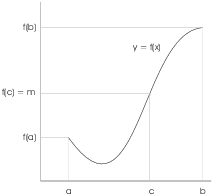
Try it for yourself: Pick any height m between ![]() and
and ![]() . Move horizontally from your
chosen height to the graph, then downward from the graph till you hit
the x-axis. The place where you hit the x-axis is c. You'll always be
able to do this if f is continuous. The intuitive idea is that, being
continuous, f can't skip any values in going from
. Move horizontally from your
chosen height to the graph, then downward from the graph till you hit
the x-axis. The place where you hit the x-axis is c. You'll always be
able to do this if f is continuous. The intuitive idea is that, being
continuous, f can't skip any values in going from ![]() to
to ![]() .
.
A proof of the Intermediate Value Theorem uses some deep properties of the real numbers, so I won't give it here. At least you can see from the picture that the result is geometrically reasonable.
The theorem illustrates an important point: You can know something exists without being able to find it.
If I take your car keys and throw them into a nearby corn field, you know that your keys are in the field --- but finding them is a different story!
The Intermediate Value Theorem says there is a number c such
that ![]() . It doesn't tell you how to find it, though
you can usually approximate c as closely as you want.
. It doesn't tell you how to find it, though
you can usually approximate c as closely as you want.
And by the way --- there may be more than one number c which works. Even though the statement of the theorem says "there is" (singular), mathematicians use these words to mean "there is at least
Example. Suppose f is a continuous function,
![]() , and
, and ![]() . Prove that for some number x
between 4 and 7,
. Prove that for some number x
between 4 and 7, ![]() .
.
Since ![]() and
and ![]() are continuous,
are continuous, ![]() is continuous. Plug in 4 and 7:
is continuous. Plug in 4 and 7:

42 is between 27 and 51, so I can apply the Intermediate Value
Theorem to ![]() . It says that there is a number x between
4 and 7 such that
. It says that there is a number x between
4 and 7 such that ![]() .
.![]()
Example. Approximate a solution to the equation
![]()
Here's the graph:
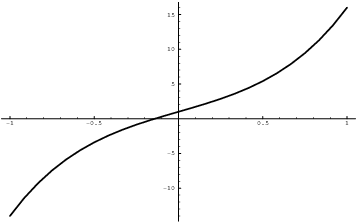
It looks as though there's a root between -0.5 and 0.
A clever person might say at this point: "Why not just look up the general formula for solving a 5-th degree equation?" After all, there's the general quadratic formula for quadratics ... and there's a general cubic formula and a general quartic formula, though you'd probably have to look them up in a book of tables.
Unfortunately, you'll never find a general quintic formula in any book of tables. Nils Henrik Abel and and Paolo Ruffini showed almost 150 years ago that there's no general quintic, and Evariste Galois showed a little later that you won't have any luck with higher degree equations, either.
You can still approximate the root, and the Intermediate Value Theorem guarantees that there is one.
f (being a polynomial) is surely continuous. In this situation, the IVT says that f can't go from negative to positive without passing through 0 somewhere in between.
Notice that
![]()
Thus, I know there's a root between -0.5 and 0.
I'll approximate the root by bisection. At each step, I'll know the root is caught between two numbers. I'll plug the midpoint into f. The root is now on one side or the other, and I just keep going.
This is exactly what common sense would lead you to do.
Here's the computation:
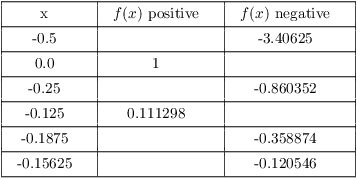
At this point, the root c is caught between -0.125 (the last x which
made f positive) and -0.15625 (the last x which made f negative).
These two numbers are 0.03125 apart. Hence, the midpoint ![]() is within
is within ![]() of
the actual root. The estimate
of
the actual root. The estimate ![]() is therefore good to
within 1 or 2 one-hundredths.
is therefore good to
within 1 or 2 one-hundredths.![]()
Copyright 2018 by Bruce Ikenaga